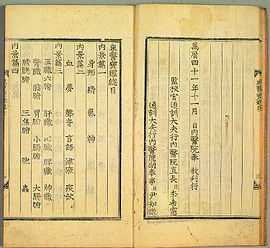Ttongsul
| Ttongsul | |
| Hangul | 똥술 |
|---|---|
| Hanja | 糞酒 |
| Revised Romanization | Ddongsul |
| McCune–Reischauer | Ttongsul |
Ttongsul, or feces wine, is a Korean traditional wine made from feces, particularly that of humans. Ttongsul was first widely introduced to the public by Vice Japan’s Yuka Uchida in 2013. She found Dr. Lee Chang Soo who makes this Korean traditional wine.[1][2]
Production

Ttongsul may be produced in either of two ways. The more time-consuming involves submerging a bamboo stick in a chamber-pot which contains feces and alcohol. It is left there for several months as it ferments, and the ttongsul is extracted from the bamboo.[3][4] A more rapid method, which may produce less favorable results, simply involves mixing alcohol and feces directly for several days.[5][6]
Origin
Medicinal compounds produced from feces have a long history in China[7] and Korea. As long ago as the Tang Dynasty, chicken manure was used this way. In Japan, equine feces have been believed to have medicinal efficacy and have been traditionally used as therapy of choice since Sengoku period. Equine feces is said to be especially effective in treating gunshot wounds by direct application to the area, or consumption by mouth or in aqueous mixture.[8][9] Recently, it is permitted to be on the market for state prototype.[10][11] Other types of feces were historically used in medicines, including those of flying squirrels, bats, hare, sparrows [12] and silkworms.
Books referring to ttongsul
- Heo Jun "Dongui bogam (동의보감)" (1613)
- 이영균 (2010). 개똥지빠귀를 위한 변론 [Argument for thrush]. 청어. ISBN 8994638059. Chapter Ⅴ. Very popular feces in Korea, Episode 5. Ttongsul
References
- ↑ "korean unko zake". Vice Japan.
- ↑ Sarah Griffiths 「Bottoms up? The bizarre traditional Korean rice wine that uses human POO to 'heal' everything from broken bones to epilepsy」 Daily Mail UK 2013/8/20
- ↑ Heo Jun "Dongui bogam (동의보감)"(1613), "將白狗屎燒成灰後混入酒中, 飲用後可治療腫瘤, 腹脹和瘀血的藥方."
- ↑ 정연식 (2001). 일상 으로 본 조선 시대 이야기, Volume 2 [The story of daily life in Joseon Dynasty]. 청년사. p. 224. ISBN 897278351X.
- ↑ Rocketnews24.com
- ↑ [커버스토리]별의별 술이 다 있네 [[Cover Story] Various sorts of alcoholic beverages] (in Korean). Naver News. September 6, 2003.
- ↑ Nie, Jing-Bao (2002). "'Human Drugs' in Chinese Medicine and the Confucian View: An Interpretive Study". Confucian Bioethics. Philosophy and Medicine 61. pp. 167–206.
- ↑ 戦国時代の舞台裏. 青春出版社. 2006. ISBN 897278351X.
- ↑ Jinbutsu Nihon no rekishi - Volume9. 1975. p. 281.
- ↑ 「馬糞」が「日本酒」になる!2000頭分の排泄物を有効活用したJRA“エコ商法”のヒット [The ech-business model of JRA, using excrement from 2000 horses was hit in Japan.] (in Japanese). Sankei News. April 13, 2013.
- ↑ "kachiuma-mai". 5 January 2013.
- ↑ Bioorganic & Medicinal Chemistry, Volume 16, Issue 3, 1 February 2008, Pages 1133-1141 , Kyoung Ah Kanga, Rui Zhanga, Mei Jing Piaoa, Dong Ok Koa, Zhi Hong Wanga, Bum Joon Kim
External links
- Korean Zake (똥술) from VICE Japan